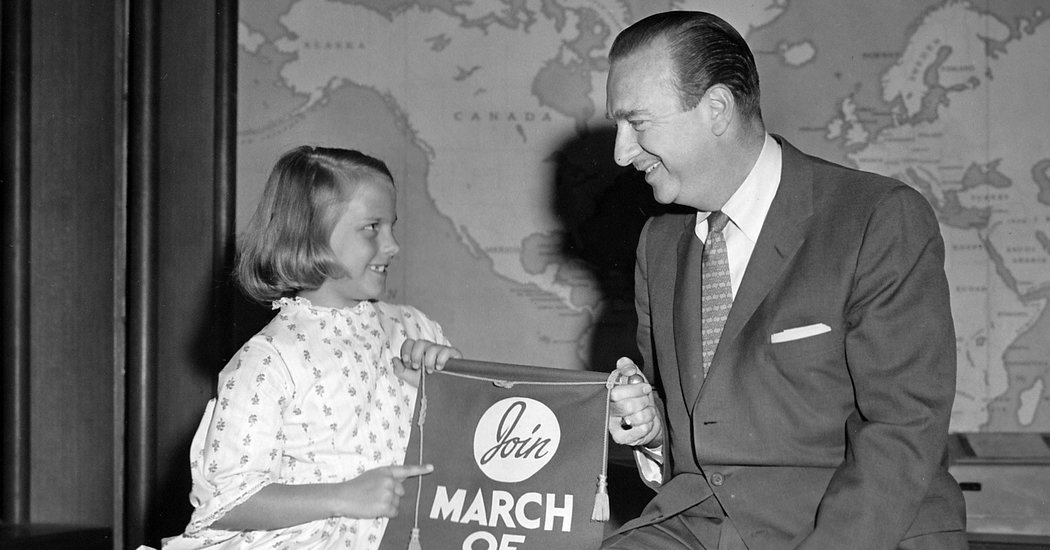
Doctors discovered that Pam Henry had polio in 1951, when she was just 14 months old. At the time, the disease infected tens of thousands of children in the United States every year, permanently disabling many of them.
Dr. Jonas Salk’s revolutionary polio vaccine, which would one day eradicate polio in the United States, would not be approved for widespread use until 1955 — too late for Pam. By then the disease, also called infantile paralysis, had made walking without crutches impossible for her.
But if she could not be cured of polio, she would nevertheless help others overcome it by becoming a face of the March of Dimes, the fund-raising campaign by the nonprofit originally called the National Foundation for Infantile Paralysis, which was dedicated to defeating the disease and had financed Dr. Salk’s research.
Ms. Henry, the last March of Dimes poster child for polio, died on Tuesday at a hospital near her home in Oklahoma City, where she later had a successful career as a television journalist. She was 68.
The cause was complications after surgery for an intestinal blockage, said Don Sherry, a friend and former colleague who made a documentary about her life.
A charming, towheaded child, Pam was first chosen to represent a local chapter of the infantile paralysis foundation in her native Oklahoma City. She then rose through what the March of Dimes archivist David Rose, in a telephone interview, compared to “a farm system in baseball” to become the charity’s national poster child for polio in 1959.
She was helped by her positivity. In Mr. Sherry’s documentary, “The Last Poster Child: The Life of Pam Henry” (2015), Ms.Henry said that her parents had taught her not to regard her disability as an unfair affliction or see herself as a victim.
“It’s not given to you as a punishment; it is a random thing that happens on planet Earth,” she said.
Ms. Henry made an impression on the many celebrities she met on her tour of the country, including Mamie Eisenhower, Tony Curtis, Lena Horne, John F. Kennedy and Eleanor Roosevelt, whose husband, President Franklin D. Roosevelt, was handicapped by polio and had established the foundation in 1938.
But it was the CBS newsmen Edward R. Murrow and Walter Cronkite who made a particularly strong impression on her. She met Mr. Cronkite in the network’s newsroom, where he was perched in front of a large map of the world.
“I took my crutch and I went up and did a weather forecast,” Ms. Henry recalled, “and he laughed and laughed.”
A fascination with broadcast journalism was sparked, and she went on to pursue it as a career. She became the first female television reporter in the Oklahoma City area.
Colleagues were struck by her determination.
“I first met Pam Henry in the middle of a three-alarm fire,” Bob Dotson, a former colleague at what was then WKY-TV, Oklahoma City’s NBC affiliate (and is now KFOR-TV), said in the documentary. “She came wading through three feet of water, on crutches, holding a microphone in her teeth.”
Ms. Henry was a general-assignment reporter, an Oklahoma state capital reporter and an anchor from the mid-1970s until the mid-1980s, when she became the news director at Oklahoma Educational Television Authority, a network of PBS stations in the state. As she grew older her disability worsened, and she went from using crutches to an electric wheelchair.
In 2001 Ms. Henry had a brain aneurysm at work and needed emergency surgery. She retired from the television authority the next year, and in 2004 she was inducted into the Oklahoma Journalism Hall of Fame.
Pamela Ruth Henry was born on Aug. 19, 1950, in Ardmore, in southern Oklahoma, to Ingram and Ruth Henry, and grew up in Oklahoma City. Her father was an oilman.
She said she had a more or less typical American childhood.
“I didn’t think I was different in a bad way; I just knew I had braces and crutches and the other children didn’t,” she said in the documentary, adding that other children accepted her regardless.
She graduated from John Marshall High School in Oklahoma City in 1968, then studied broadcast journalism at the University of Oklahoma, graduating in 1972.
In 1976 she married David Holliday, an aide to Oklahoma’s governor at the time, David Boren, who was later a Democratic United States senator. The marriage ended in divorce. She leaves no immediate survivors.
Ms. Henry remained a champion for the disabled long after she was a poster child for March of Dimes, which now goes by that name and focuses primarily on premature birth. After she retired she became the head of a mayoral commission in Oklahoma City to help disabled people, and was annoyed by employers who avoided hiring them.
“They think they’ll be a problem, or sick more often, when in fact they’re getting the most loyal employee they could ever get, when in fact this person wants a job and sees it as a blessing,” Ms. Henry said. “There’s no 9-to-5 with a handicapped person: They want to go to work, they want to be independent.”
Follow Daniel E. Slotnik on Twitter: @dslotnik

